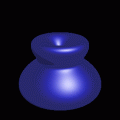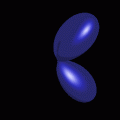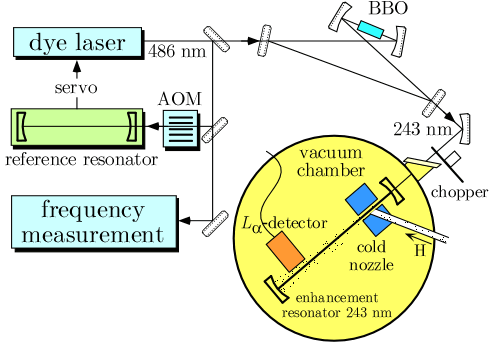
High Precision Measurements for fundamental Physics

 |
High Precision Measurements for fundamental Physics |
 |
ResearchWe are part of the group of Prof. T. W. Hänsch and located at the Max-Planck Institute for Quantum Optics Garching/Germany.  Atomic HydrogenThe
hydrogen atom is the simplest of all atoms and can therefore be treated
theoretically with the utmost precision. The underlying theory is
quantum electrodynamics (QED) that currently allows to determine energy
levels with 12 significant digits of accuracy. To fully exploit
this capability, that no other physical theory can provide, we are
determined to provide experimental data that are at least as accurate.
Currently the best measured quantity is the sharpest of all transitions
of the hydrogen atom, which is the dipole forbidden 1S-2S transitions
whose frequency we determined to be:
When
comparing with the theoretical expression one finds that it
contains two terms that contribute about equally to its uncertainty. This means not
only the Rydberg constant that sets the scale for all atomic energy levels can be determined
from such a comparison but it also that at least two measurements
have to be used. However, the best analysis is to combine with all other transition
frequencies that have been measured, many of them provided by the group of Francoise
Biraben at the Laboratoire Kastler Brossel Paris. In this way the Rydberg constant
is fixed as one of the most accurately known fundamental constants. It's value is used for expample to derive a value for the
fine structure constant alpha from independent determinations of the
electrons mass devided by Planck's constant. This method has the
potential to convert all digits since the of the
speed of light has a defined (exact) value within the SI systen of
unit.
Traditionaly the comparision with the results of quantum electrodynamics (QED) is done by using only small fraction of the energy levels called the Lamb shift which is roughly the deviation of QED from its precessing theory by Dirac. The largest of these Lamb shifts is the one of the 1s level that is determined to be
from the world experimetal data. Because at least two hydrogen transition frequencies enter to determine the two esults above, the second most precise measurement is limiting the overall accuracy. The 1S-2S transition frequency is known with almost 14 digits of accuracy while all other transition frequencies have been measured with much lower accuracy. This is the one motivation for our eforts on the 1S-3S transition frequency as explained below. To read more please click here: pdf The 1S-2S TransitionIn
the 1S-2S experiment hydrogen atoms are excited by longitudinal
Doppler-free two photon excitation at 243nm. This radiation is
generated by a frequency doubled ultra stable dye laser at
486nm. The UV radiation is then resonantly enhanced in a linear cavity
inside a vacuum chamber. Atomic hydrogen from a gas discharge is
directed through a nozzle cooled with liquid helium. The cold atomic
beam is oriented along the axis of the enhancement resonator. After the
atoms have passed some distance, usually around 10cm, a small
electric field that mixes the metastable 2S state (lifetime 1/7 sec)
with the fast decaying 2P state is applied. This releases a Lyman alpha
photon which is registered with a photo multiplier tube. To reduce the
residual
second order Doppler-effect we use a delayed detection scheme where the
fluorescence at 121nm is detected only after the exciting light has
been switched off for some period of time, typically between 0.5 and 1.8ms. In this way we set an upper limit on the second order Doppler-shift below 1kHz.
 Part of the 486nm radiation from the ultra stable dye laser is transfered to a frequency comb to determine its frequency with the help of a GPS disciplined hydrogen maser or a Cs atomic clock. Besides the determination of the Rydberg constant and testing QED, another application is the search for a possible slow temporal variations of the fundamental constants that is suggested by some philosophical arguments. To read more please click here: pdf The 1S-3S TransitionAs
pointed out above, results derived from a set of hydrogen transition
frequencies, will be limited in accuracy by the second most precise
determination of
these transitions. Therefore a measurement of another frequency besides
the 1S-2S transition frequency within 14 digits of accuracy would
significantly reduce the uncertainty of the Rydberg constant and the
Lamb shifts. As QED allows to convert the Lamb shifts of any
level into the Lamb shift of any other with very small
uncertainty, it does not really matter which of the transition
frequencies is used to complement the 1S-2S frequency. The right choice
should therefore take the experimental simplicity, the sensitivity
to systematic shifts and the line width into account. We
have been trying to detect the 1S-3S transition signal not only
for these reasons but also because we want to
further develop direct frequency comb spectroscopy. The required
wavelength of 205nm is very close to the short
wavelength cut-off for
second harmonic generation in beta barium borate (BBO). The crystal is
highly susceptible for unwanted non-linear
effects such as photo refractivity that has so far prevented its use
with continuous wave lasers. In our experiment we want to use a pulsed
mode locked laser instead. Such a laser posses a comb like spectrum
with narrow band modes that can be used in pairs for two photon
excitation.
It has been shown by E.V.Baklanov and V.P.Chebotayev already in the
1970s, that with such a frequency comb excitation the effective
excitation rate derives from the intensity of all modes together while
the line width can be as narrow as that of a single mode of the
frequency comb. To explore
these possibilities could proof very useful when much shorter
wavelengths are required, for example for the excitation of the 1S-2S
transition in hydrogen like helium.
The 2S Hyperfine SplittingThe
frequency of the 2S hyperfine interval is one of the best measured
quantities in physics with about 13 digits known. The hyperfine
interaction depends largely on the structure of the nucleus that can
not be calculated from first principles with the required accuracy.
Therefore the 2S hyperfine interval can not be used directly to test
quantum electrodynamics. However, if combined with 8 times the
hyperfine splitting of the 2S state according to
Click here to read more: pdf Narrow Linewidth LasersTo
probe narrow transitions in atomic hydrogen one prerequisite is a
laser whose line width is even narrower. For this reason we stabilize
our spectroscopy lasers to high finesse cavities that are
immunized and isolated from external perturbations such as
temperature variations and vibrations. To compensate for thermal drifts the
cavity spacers, that hold the mirrors apart, are made from ultralow expansion (ULE) glass which possesses
a zero linear thermal expansion coefficient. A design using Peltier elements in
vacuum allows operation at an optimal temperature where the quadratic
temperature expansion of ULE could be eliminated as well. The spacers are mounted vertically and suspended in midplane such that the influence of
vertical vibrations to the mirror separation is significantly
suppressed. This makes the setup virtually immune for vertical
vibrations that are more difficult to isolate than horizontal
vibrations. We
achieve a finesse of up to 400,000 with a drift of the optical
frequency of 0.06Hz per seconod limited by material aging.The short term stability is dominated by
thermally induced fluctuations of the mirror surface position.
Nevertheless a laser line width of 0.5Hz has been measured by
comparing two of these cavities in our lab.
Click here to read more: pdf Atomic ClocksTo
generate the time base for our experiments we operate a clock system
that consists of an active hydrogen maser, a cesium atomic clock, two
GPS receivers and a computer for monitoring an steering. The complete
system is connected to an uninterruptible power supply and is located
an a quite room with very good temperature stability. We calibrate the
maser by comparing it with the time signals broad casted by GPS.
Comparing our data with similar data generated at the Physikalisch
Technische Bundesanstalt at Braunschweig (PTB) allows us to calibrate
our maser relative to the PTB clocks. A frequency comb is used to
convert the masers reference frequency into the optical and distribute
is via a fiber network throughout the institute.
|